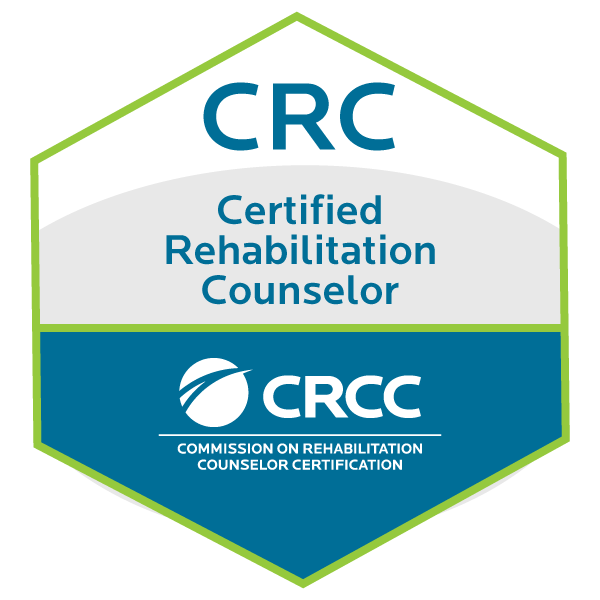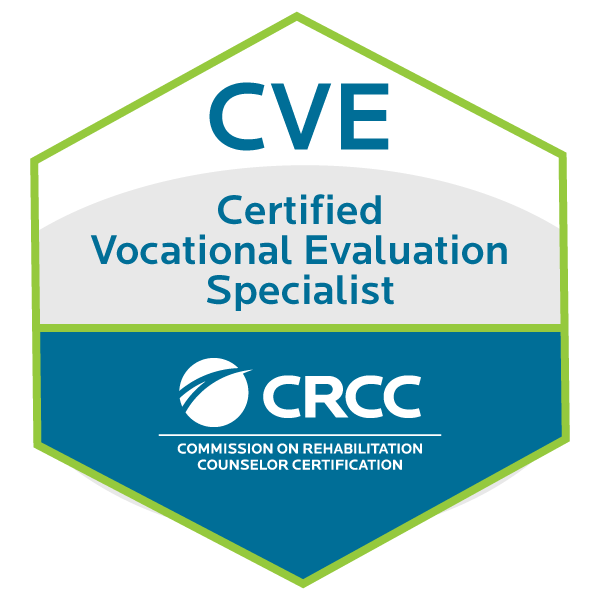Vocational Evaluation
and the Disability Determination Process
A slide presentation first given to a CLE class hosted by Wayne Wright, L.L.P.
- Panel 1
- Panel 2
- Panel 3
- Panel 4
- Panel 5
- Panel 6
- Panel 7
- Panel 8
- Panel 9
- Panel 10
- Panel 11
- Panel 12
- Panel 13
- Panel 14
- Panel 15
- Panel 16
- Panel 17
- Panel 18
- Panel 19
- Panel 20
- Panel 21
- Panel 22
- Panel 23
- Panel 24
- Panel 25
- Panel 26
- Panel 27
- Panel 28
- Panel 29
- Panel 30
- Panel 31
- Panel 32
- Panel 33
- Panel 34
- Panel 35
- Panel 36
- Panel 37
Vocational Evaluation
and the Disability Determination Process
Brad Coffey, M.Ed., MBA
Vocational Rehabilitation Counselor and Consultant
Purpose of presentation
- To enable you to better understand the components of vocational opinions
- To help you anticipate the direction of vocational evaluation on your cases
- To possibly improve your vocational examination
Outline
- The origins of vocational evaluation in the Social Security disability determination process
- The qualified vocational expert
- The vocational expert at Step 4
- The vocational expert at Step 5
- The concept of skills and transferability
A. Origins of vocational evaluation in Social Security
A. Origins of vocational evaluation in Social Security
Kerner v Flemming (1960)
- Kerner had diabetes and a heart condition
- Work history as a car mechanic, salesman and carpenter
- Determinations in the 1950s were based on hearing officer’s “common knowledge” of relating medical conditions to the world of work. Kerner was denied.
- Appeals court decided that the basis of denial was “theoretical”--No case-specific vocational factors had been considered, such as age, education and work experience.
B. The qualified vocational expert
B. The qualified vocational expert
SS calls on professionals who are usually licensed professional counselors, vocational rehabilitation specialists or other professionals whose career has involved job placement, career counseling and working with job placement for the disabled.
B. The qualified vocational expert
Vocational rehabilitation counselor
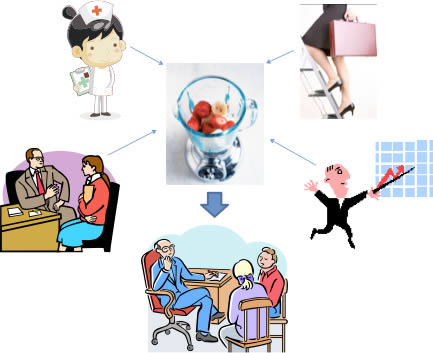
B. The qualified vocational expert
Vocational rehabilitation counselor
Historically:
The profession emerged with the first world war, to answer the needs of returning veterans who had severe injuries and needed to be employed again. The rehabilitation services provided were so popular with the public, that they pushed for laws that funded state-federal programs for all.
B. The qualified vocational expert
Vocational rehabilitation counselor and consultant
The “consultant” is an experienced counselor who provides information to case stakeholders for case decision making. The “client” is usually the retaining party. The injured worker is the “evaluee.”
Vocational evaluation: A process of information gathering for the purpose of matching a person with suitable occupations

C. The vocational expert (VE) at Step 4
C. The vocational expert (VE) at Step 4
- Even though the VE is questioned by the judge and retained by ODAR, the VE is neither the government’s nor claimant’s witness.
- VE’s task is to offer an impartial opinion based on 1) evidence from the record and 2) the judge’s (and/or representative’s) determinations as to the claimant’s limitations.
C. The vocational expert (VE) at Step 4
Tools of the VE:
- Reference: Dictionary of Occupational Titles (DOT) by U.S. Dept of Labor
- Reference: Selected Characteristics of Occupations as Defined in the DOT
- Database: Statistical data from Bureau of Labor Statistics
- Software: Electronic versions of above
- Career knowledge and experience placing persons with disabilities in various work environments
C. The vocational expert (VE) at Step 4
VEs are generally called when one of the following conditions exists:
- A case cannot be decided using the Medical-Vocational Guidelines (Grids)
- There is an issue as to the skill level of the claimant's former work
- The claim will pivot on the issue of transferable skills
- A combination of exertional and non-exertional impairments is involved
- Significant non-exertional impairments are involved
- The claimant falls between 2 exertional levels or cannot do a full range of work at a given exertional level
- The claimant's past relevant jobs appear to have been performed quite differently from the customary manner
- When an ALJ is direct by the Appeals Counsel or pursuant to court remand to use a VE
C. The vocational expert (VE) at Step 4
Step 4: The essential questionis:
Can the claimant return to past relevant work?
C. The vocational expert (VE) at Step 4
Step 4: Can the claimant do past relevant work (PRW)?
- When an ALJ cannot find "disability" on medical considerations alone, he or she then determines a claimant's RFC (Residual Functional Capacity) based on exertional and non-exertional limitations evidenced from the medical record and testimony, and makes a finding on the claimant's capacity to meet the exertional demands of work in terms of "very heavy," "heavy," "medium," "light," and "sedentary" as defined in the regulations and the Dictionary of Occupational Titles (DOT).
- Likewise, any non-exertional limitations such as diminished vision, inability to concentrate, environmental restrictions, fatigue, pain, etc. are determined.
- The RFC is then considered, along with the claimant's age, education and past work experience, in making a finding as to whether the claimant has the ability to meet the physical and mental demands of his or her past relevant work.
C. The vocational expert (VE) at Step 4
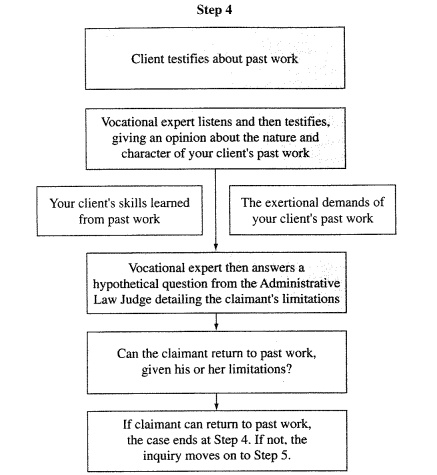
C. The vocational expert (VE) at Step 4
ALJ Questioning:
- 1. Please describe the past relevant work in terms of skill and exertional level?
- Given these limitations: ( ex- HS ed, limited to 20 lbs max lift/carry, detailed but not complex work) could the claimant return to past work? If no, why not?
Questions that may be asked, but infrequently:
- Does the claimant have skills that are transferable to other jobs? If yes, what are they? * (I rarely get this at Step 4)
- Does the claimant have education or training to permit them to directly enter skilled work? (only if recent)
- How would you classify this individuals RFC, given these limitation? (rarely get this, but I have in the past)
C. The vocational expert (VE) at Step 4
Two points about that ALJ questioning:
A claimant's testimony (written or verbal) describes how he/she actually performed past work, which may differ from the DOT. If different, it becomes the VE's and the representative's task to fully define the claimant's job performance so that it can be determined if they can return to past work.
If the claimant has acquired skills (SVP is atleast 3) that can be applied to jobs outside of PRW, it means a wider range of jobs are available to the claimant in the economy. The assessment of skills becomes the foundation for later testimony at Step 5.
C. The vocational expert (VE) at Step 4
Representative questioning:
- Assume for me that the claimant suffers from cerebral palsy. Would he/she be able to perform past work?
VE cannot respond. The representative has not asked the VE about limitations, asking instead about the effect of an impairment, without any quantification of information. To be vocationally understandable, the functional effects of an impairment must be quantified.
VE: "Can you tell me what the limitations are as a result of the cerebral palsy?" - Assume that the claimant can’t concentrate for very long at one time. Would she be able to return to past work?
VE: "I can't answer that question. I don't know how long you mean when you say 'very long.'"
D. The vocational expert at Step 5
D. The vocational expert at Step 5
Step 5: Can the claimant do other work?
- When an ALJ determines that a claimant cannot perform past relevant work, he or she must then consider RFC, age, education, past work experience, and- depending on age- transferable skills to ascertain if other work exists in significant numbers in the regional or national economy which the claimant can perform.
- Depending on the claimant's age, other work may also include unskilled occupations that exist in significant numbers.
D. The vocational expert at Step 5
Critical Factors at Step 5:
- Claimant's age
- Education
- Previous work experience
- Functional capacity
D. The vocational expert at Step 5
Questions are posed in a series of hypothetical questions, beginning with the least restrictive RFC and adding new limitations with each additional hypothetical question.
D. The vocational expert at Step 5
- A Hypothetical—what if?—question is used to question the VE because an expert is rendering an opinion that will affect the claimant, even though the expert does not know anything about the claimant's actual abilities, by first-hand evaluation.
- The limitations being asked to consider may or may not be supported by a preponderance of the evidence.
D. The vocational expert at Step 5
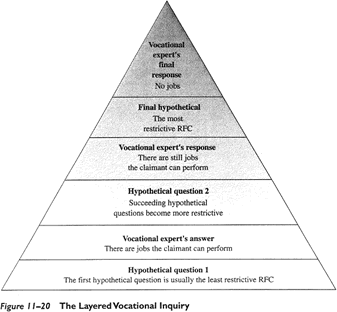
D. The vocational expert at Step 5
The layered effect allows both the judge and the representative to clearly delineate the claimant's restrictions, and further allows the representative to monitor the limitations the judge is considering.
Therefore, Individual limitation and combinations of limitations may be considered. Later, the judge makes a determination as to which limitations are actually supported by evidence and testimony.
D. The vocational expert at Step 5
Hypo 1: “Assume with me an individual the same age as the claimant, with the same vocational and educational history. Assume they are able to do a full range of light work. Are there jobs within the regional or national economies such a person can do?”
E. The concept of skills and transferability
E. The concept of skills and transferability
The concept of transferability of skills arose out of post-war manpower needs.
Early definition of skill (1950s):
- Skill: … a worker’s [applied] knowledge and abilities, acquired through training and experience, to do a particular job.
E. The concept of skills and transferability
Early definition of transferability (1950s):
- Transferability of skills: the continuous use of acquired knowledge and abilities when moving from one job to another.
E. The concept of skills and transferability
From SSR 82-41:
Skill: ... knowledge of a work activity which requires the exercise of significant judgment … acquired through performance of [tasks in a position within] an occupation
Transferability: … applying work skills which a person had demonstrated in vocationally relevant past jobs to meet the requirements of other skilled and semiskilled jobs
E. The concept of skills and transferability
The principle of “continuous use” is established on the basis of similarity between jobs.
Similarity is determined by comparing relevant occupational elements:
- What a worker does … with data, people, things
- What gets done in jobs
- The materials, products, subject matter, services
E. The concept of skills and transferability

Purpose of presentation
- To enable you to better understand the components of vocational opinions
- To help you anticipate the direction of vocational evaluation on your cases
- To possibly improve your vocational examination
Sources
Blackwell, T.L., Field, T.F., and Field, J.E. (1992). The Vocational Expert Under Social Security. Elliott & Fitzpatrick.
Field, T.F., Dunn, P.L. (in press). Transferability of Skills: Historical Foundations and Development.
Parker, R. M., et al. (2005). Rehabilitation Counseling: Basics and Beyond. Austin, TX: Pro-Ed.
Wolfe, J.S. and Proszek, L.B. (2003). Social Security Disability and the Legal Professional. Delmar Cengage Learning.
Contact
R. Brad Coffey
Re-Employment Resources, L.C.
1100 NW Loop 410, Ste. 700
San Antonio, TX 78213
210-366-8780


